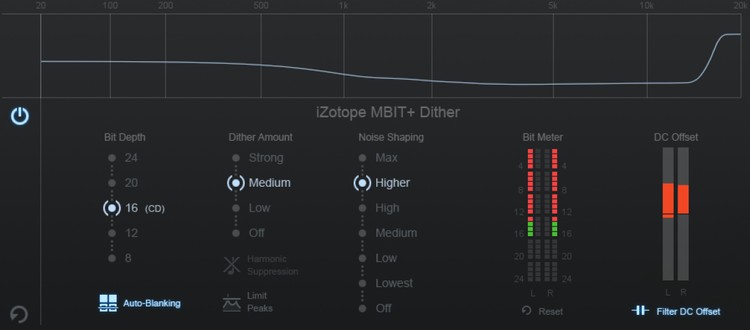Bit Depth and Dithering
In a professional environment Dithering will be applied to audio clips when reducing word length. This process will mask errors that occur due to the removal of digital audio bits. I thought I’d cover the basics.
Digital Audio
Digital Audio incorporates individual samples consisting of bits created by the process of Quantization. This is essentially the conversion of a continuous, linear range of values present in analog audio into a fixed range of discrete values. Bit Depth (a.k.a. Word Length or Resolution) represents the number of bits stored in a sample’s measure of amplitude. It indicates the extent of inherent vertical precision. Higher bit depths (or bits per sample) encompass improved vertical dynamic resolution resulting in an extended Dynamic Range.
1 bit = 6dB of Dynamic Range. Theoretically 16bit audio has a quantified Dynamic Range of 96 dB. 24bit audio has a quantified Dynamic Range of 144 dB. However, in order to accurately assess Dynamic Rage we must also recognize the amplitude of the highest spectral component of the inherent noise floor. Specifically, where it resides relative to the maximum Peak value that a system is capable of reproducing. Dynamic Range is the measurement of this ratio or range.
Signal to Noise Ratio (SNR) is the quantified range between the nominal average signal level and the average level of the noise floor. Audio with an extended Dynamic Range will exhibit a higher SNR compared to audio with a reduced Dynamic Range. In essence 24bit audio will allow you to work with additional headroom without any increase in noise compared to 16bit audio.
Word Length Reduction
Truncation is the removal of bits with no compensating replacement. The repositioning of samples after converting to a lower resolution creates Quantization Errors resulting in audible artifacts and distortion. Dithering is technology that adds minimal perceived noise to audio before word length reduction. This noise will minimize and/or mask the audibility of distortion caused by Quantization Errors. It will also help preserve the sound quality and Dynamic Range of a higher resolution clip when converting or exporting to a lower bit depth.
There is a trade off: you are replacing bad noise with alternative “good” noise that is smoother, less audible, and much more consistent.
Noise Shaping is a supplemental feature that pushes Dithering noise into frequency ranges that are less audible to humans, thus allowing greater Dither with reduced perceptual noise.
Take a look at the Noise Shaped frequency response curve in the attached image. There is a clear visual indication of increased gain at higher frequencies that we are less susceptible to.
Podcasting
So what does this all mean for the typical Podcast Producer? Is Dithering just another obscure aspect of professional Audio Mastering and Post Production that can be safely ignored?
Consider the following variables:
If you are recording spoken word in a well suited environment that is reasonable quiet, and you are using capable (and trouble free) gear that is properly configured, there is really no reason to record 24bit audio. In my honest opinion with proper handling 16bit audio from acquisition to distribution will be perfectly acceptable.
Remember, I’m specifically referring to spoken word audio slated for Podcast distribution. If you are tracking music, well then by all means make full use of the advantages of higher resolution audio recording.
If you elect to record 24bit audio, and you are not properly implementing the word length reduction to 16bit, you are essentially nulling the advantages of the original higher resolution audio. When down-converting, you will be unknowingly degrading the sound quality by introducing artifacts and distortion. That’s not my opinion – it is a fact.
Consider this: The stand-alone version of iZotope’s Ozone 7 Mastering Suite processes all imported audio to 32bit word length. The manual specifically states:
“If you select a bit depth other than 32-bit, you may want to apply dither to your export. Ozone processes files at 32-bit so dither is desirable for files being exported to values lower than 32-bit.”
Most DAWS include Dithering options. In some cases it’s by way of a plugin. You may also notice Dithering options included in application Preferences or Export dialogs. Hopefully after reading this article you will understand what it all means and whether you should consider implementing it. Please note that Dither must be applied at the very last stage of any processing chain.
-paul.
Julian Ludwig é diretor do Pro Áudio Clube, produtora de áudio Jacarandá, Loc On Demand e Jacarandá Licensing. Trabalhou para empresas como: Guaraná Antartica, TV Gazeta, NET, Chivas Regal, FNAC, Prefeitura de São Paulo, Mukeca Filmes, Agência LEW’LARA TBWA, Agencia MPM, Agência Content House entre outras. Fez trilhas para programas de TV como: Internet-se (Rede TV), Você Bonita (TV Gazeta), Mix Mulher (TV Gazeta), Os Impedidos (TV Gazeta), Estação Pet (TV Gazeta), CQC (TV Band) Vinheta Oficial TV Gazeta, entre outras. Também atuou em vários longas e curtas metragens, incluindo mixagem em 5.1 e serviços de pós-produção.

